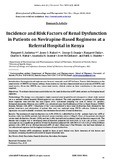| dc.contributor.author | Ambetsa, Margaret O | |
| dc.contributor.author | Makori, Jones O. | |
| dc.contributor.author | Osanjo, George O | |
| dc.contributor.author | Oluka, Margaret | |
| dc.contributor.author | Maitai, Charles K | |
| dc.contributor.author | Guantai, Anastasia N | |
| dc.contributor.author | McClelland, Scott | |
| dc.contributor.author | Okalebo, Faith A | |
| dc.date.accessioned | 2015-11-30T09:55:00Z | |
| dc.date.available | 2015-11-30T09:55:00Z | |
| dc.date.issued | 2015 | |
| dc.identifier.citation | Ambetsa, M. O., Makori, J. O., Osanjo, G. O., & Oluka, M. (2015). Incidence and Risk Factors of Renal Dysfunction in Patients on Nevirapine-Based Regimens at a Referral Hospital in Kenya. African Journal of Pharmacology and Therapeutics Vol, 4(2), 48-58. | en_US |
| dc.identifier.uri | http://hdl.handle.net/11295/92702 | |
| dc.description.abstract | Introduction: Nevirapine-based regimens are the most commonly used ART in Kenya. There is little literature on the
renal toxicity of NNRTIS in Kenyan settings. Some studies in Asia have demonstrated an association of NNRTIs and
renal toxicity. Given that NNRTIs may cause renal toxicity, clinical studies on their contribution to the same are
required.
Objectives: To evaluate the incidence and risk factors for renal dysfunction in HIV adult patients on Nevirapine based
regimens.
Methodology: The design was a descriptive (right censored arm) hospital based retrospective cohort study carried
out at a national referral hospital. Ethical approval was obtained. The study population was patients on Nevirapine
based regimens seen between May and August, 2014. Convenient sampling was used to recruit 241 patients.
Estimated glomerular filtration rate (eGFR) was calculated using the Modification of Diet in Renal Disease (MDRD)
formula. Patients with eGFR < 50ml/min/1.73m2 were considered to have renal dysfunction. Data obtained by the
patient interviews and abstraction of patient files and was analyzed using STATA software. Ordered Logistic
regression was used to identify covariates that determine the severity of renal dysfunction.
Results: The incidence of renal dysfunction was 4.3% (95% C.I, 1.68-6.94).Five (2.1%) patients had a low eGFR at
baseline, while ten (8.3%) patients had elevated serum creatinine (above 120μg/l). None of the patients developed
severe renal dysfunction. Seventy (32%) and ten (4.6%) had mild and moderate renal dysfunction respectively. The
females had a higher risk of developing renal dysfunction (adjusted O.R 0.48 (95% C.I 0.24-1.04; p=0.04). Alcohol
consumption was a significant predictor of renal dysfunction (adjusted O.R 1.84 (95% C.I 1.01-3.29; p=0.04).All fifteen
patients with a BMI of over 18.5 had elevated eGFR of below 50ml/min/1.73m.2Patients who had been initiated on
stavudine based regimens had the highest incidence of renal dysfunction.
Conclusion: Routine eGFR calculations should be done at each clinical visit. Early detection of risk factors and
systematic screening should be advocated for improved patient care. | en_US |
| dc.language.iso | en | en_US |
| dc.subject | Body Mass Index, Renal dysfunction, Stavudine, Nevirapine | en_US |
| dc.title | Incidence and risk factors of renal dysfunction in patients on nevirapine-based regimens at a Referral Hospital in Kenya | en_US |
| dc.type | Article | en_US |

